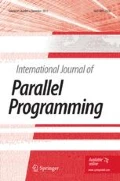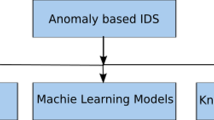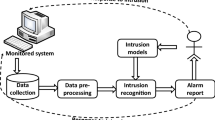Abstract
In recent years, artificial intelligence and bio-inspired computing methodologies have risen rapidly and have been successfully applied to many fields. Bio-inspired network systems are a field of biology and computer science, it has the high relation to the bio-inspired computing and bio-inspired system. It has the self-organizing and self-healing characteristics that help them in achieving complex tasks with much ease in the network environment. Software-defined networking provides a breakthrough in network transformation. However, increasing network requirement and focus on the controller for determining the network functionality and resources allocations aims at self-management capabilities. More recently, the artificial bee colony (ABC) algorithm has been used to solve the issues of parameter optimization. In this paper, a discretized food source for an artificial bee colony (DfABC) optimization algorithm is proposed and applied to optimize the kernel parameters of a support vector machine (SVM) model, creating a new hybrid. In order to further improve prediction accuracy, the proposed DfABC algorithm is applied to six popular UCI datasets. We also compare the DfABC algorithm to particle swarm optimization (PSO), the genetic algorithm (GA), and the original ABC algorithm. The experimental results show that the proposed DfABC-SVM model achieves better classification accuracy with a shorter convergence time, outperforming the other hybrid artificial intelligence models.







Similar content being viewed by others
References
Aborokbah, M.M., Al-Mutairi, S., Sangaiah, A.K., Samuel, O.W.: Adaptive context aware decision computing paradigm for intensive health care delivery in smart cities-a case analysis. Sustain. Cities Soc. (2017). https://doi.org/10.1016/j.scs.2017.09.004
Ahn, H., Kim, K.J.: Bankruptcy prediction modeling with hybrid case-based reasoning and genetic algorithms approach. Appl. Soft Comput. 9, 599–607 (2009)
Alibrandi, U., Alani, A.M., Ricciardi, G.: A new sampling strategy for SVM-based response surface for structural reliability analysis. Probab. Eng. Mech. 41, 1–12 (2015)
Asogbon, M.G., Samuel, O.W., Omisore, M.O., Awonusi, O.: Enhanced neuro-fuzzy system based on genetic algorithm for medical diagnosis. J. Med. Diagn. Methods (2016). https://doi.org/10.4172/2168-9784.1000205
Bonabeau, E., Dorigo, M., Theraulaz, G.: Swarm Intelligence: From Natural to Artificial Intelligence. Oxford University Press, New York, NY (1999)
Boritz, J.E., Kennedy, D.B.: Effectiveness of neural network types for prediction of business failure. Expert Syst. Appl. 9, 503–512 (1995)
Carlos, S.C.: Self-organizing neural networks for financial diagnosis. Decis. Support Syst. 17, 227–238 (1996)
Chen, M.Y.: A hybrid ANFIS model for business failure prediction utilizing particle swarm optimization and subtractive clustering. Inf. Sci. 220, 180–195 (2013)
Chen, M.Y., Fan, M.H., Chen, Y.L.: Wei HM (2013) Design of experiments on neural network’s parameters optimization for time series forecasting in stock markets. Neural Netw. World 23(4), 369–393 (2013)
Chen, W.C., Hsu, Y.Y., Hsieh, L.F., Tai, P.H.: A systematic optimization approach for assembly sequence planning using Taguchi method, DOE, and BPNN. Expert Syst. Appl. 37, 716–726 (2010)
Dressler, F.: Self-Organization in Sensor and Actor Networks. Wiley, Hoboken (2007)
Dressler, F., Akan, O.B.: Bio-inspired networking: from theory to practice. IEEE Commun. Mag. 48(11), 176–183 (2010)
Eberhart, R.C., Kennedy, J.: A new optimizer using particle swarm theory. In: Proceedings of the Sixth International Symposium on Micro Machine and Human Science (Nagoya, Japan), IEEE Service Center, Piscataway, NJ, pp. 39–43 (1995)
Fujibuchi, W., Kato, T.: Classification of heterogeneous microarray data by maximum entropy kernel. BMC Bioinform. 8, 267 (2007). https://doi.org/10.1186/1471-2105-8-267
Harish, N., Mandal, S., Rao, S., Patil, S.G.: Particle swarm optimization based support vector machine for damage level prediction of non-reshaped berm breakwater. Appl. Soft Comput. 27, 313–321 (2015)
Hsieh, T.J., Hsiao, H.F., Yeh, W.C.: Mining financial distress trend data using penalty guided support vector machines based on hybrid of particle swarm optimization and artificial bee colony algorithm. Neuro Comput. 82, 196–206 (2012)
Hsu, C.W, Chang, C.C., Lin, C.J.: (2010) A practical guide to support vector classification, Technical Report. Department of Computer Science, National Taiwan University, 2010. http://www.csie.ntu.edu.tw/~cjlin/papers/guide/guide.pdf/
Karaboga, D.: An idea based on honey bee swarm for numerical optimiza-tion, Technical Report-TR06, Erciyes University, Engineering Faculty, Computer Engineering Department (2005)
Karaboga, D., Akay, B.: A comparative study of artificial bee colony algorithm. Appl. Math. Comput. 214, 108–132 (2009)
Karaboga, D., Basturk, B.: A powerful and efficient algorithm for numerical function optimization: artificial bee colony (ABC) algorithm. J. Glob. Optim. 39, 459–471 (2007)
Karaboga, D., Basturk, B.: On the performance of artificial bee colony (ABC) algorithm. Appl. Soft Comput. 8, 687–697 (2008)
Kennedy, J., Eberhart, R.: Particle swarm optimization. Proc. IEEE Int. Conf. Neural Netw. 4, 1942–1948 (1995)
Liu, Z., Wang, L., Zhang, Y., Chen, C.L.P.: A SVM controller for the stable walking of biped robots based on small sample sizes. Appl. Soft Comput. 38, 738–753 (2016)
Rathore, H.: Bio-inspired software-defined networking. In: Mapping Biological Systems to Network Systems, pp. 107–115. Springer, Cham (2016)
Samuel, O.W., Asogbon, G.M., Sangaiah, A.K., Fang, P., Li, G.: An integrated decision support system based on ANN and Fuzzy_AHP for heart failure risk prediction. Expert Syst. Appl. 68, 163–172 (2017)
Sangaiah, A.K., Samuel, O.W., Li, X., Abdel-Basset, M., Wang, H.: Towards an efficient risk assessment in software projects-Fuzzy reinforcement paradigm. Comput. Electr. Eng. (2017). https://doi.org/10.1016/j.compeleceng.2017.07.022
Sebtosheikh, M.A., Salehi, A.: Lithology prediction by support vector classifiers using inverted seismic attributes data and petrophysical Logs as a new approach and Investigation of training data set size effect on its performance in a heterogeneous carbonate reservoir. J. Pet. Sci. Eng. 134, 143–149 (2015)
Srinivasan, D, Seow, T.H.: Evolutionary Computation, CEC’03, 8-12 Dec. 2003, 4, Canberra, Australia, pp. 2292–2297 (2003)
Taguchi, G.: Taguchi Methods, Research and Development. American Suppliers Institute Press, Dearborn (1991)
Taguchi, G.: Taguchi Methods, Signal-to-Noise Ratio for Quality Evaluation. American Suppliers Institute Press, Dearborn (1991)
Teodorovicˇ, D.: Transport modeling by multi-agent systems: a swarm intellgence approach. Transp. Plan. Technol. 26(4), 289–312 (2003)
Teodorovicˇ, D., Dell’orco, M.: Bee colony optimisation—a cooperative learning approach to complex transportation problems. In: 10th EWGT Meeting, Poznan, pp. 13–16 (2005)
Tereshko, V.: Reaction-diffusion model of a honeybee colony’s foraging behaviour. In: Schoenauer, M., et al. (eds.) Parallel Problem Solving from Nature VI. Lecture Notes in Computer Science, vol. 1917, pp. 807–816. Springer, Berlin (2000)
Tereshko, V., Lee, T.: How information mapping patterns determine foraging behaviour of a honey bee colony. Open. Syst. Inf. Dyn. 9, 181–193 (2002)
Tzeng, Y.F., Chen, F.C.: Multi-objective optimisation of high-speed electrical discharge machining process using a Taguchi fuzzy-based approach. Mater. Des. 28, 1159–1168 (2007)
Vapnik, V., Cortes, C.: Support-vector networks. Mach. Learn. 20, 273–297 (1995)
Wedde, H.F., Farooq, M., Zhang, Y.: BeeHive: an efficient fault-tolerant routing algorithm inspired by honey bee behavior, ant colony, optimization and swarm intelligence. In: 4th International Workshop, ANTS 2004, Brussels, Belgium, pp. 5–8 (2004)
Zhou, Z., Lin, T.: Survivable probability of SDN-enabled cloud networking with random physical link failure. CoRR abs/1709.03096 (2017)
Acknowledgements
The authors would like to thank the Ministry of Science and Technology of Taiwan for Grants MOST106-2410-H-025-007, MOST-103-2410-H-025-022-MY2 and National Science Council of Taiwan for Grants NSC-101-2410-H-025-004-MY2 which supported part of this research.
Author information
Authors and Affiliations
Corresponding author
Rights and permissions
About this article
Cite this article
Chiang, HS., Sangaiah, A.K., Chen, MY. et al. A Novel Artificial Bee Colony Optimization Algorithm with SVM for Bio-inspired Software-Defined Networking. Int J Parallel Prog 48, 310–328 (2020). https://doi.org/10.1007/s10766-018-0594-6
Received:
Accepted:
Published:
Issue Date:
DOI: https://doi.org/10.1007/s10766-018-0594-6




